
The California red-legged frog because it is big and so are its eggs?
<-- photo by K. Greene --
 The coast range newt, after all, it is full of deadly neurotoxins?
The coast range newt, after all, it is full of deadly neurotoxins?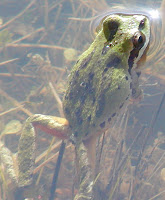
Or, the Pacific treefrog because there are so many of them, they're so darn loud and they wear a superhero mask?
I suspect the kingship has something to do with eating habits.
 At the Dipper Ponds this year, I first spotted a few clusters of red-legged frog eggs in early February. The eggs were approximately 1/2 inch in diameter and tightly wedged together like grapes in fist-sized or larger clusters. On Sunday, I saw a few dark tadpoles already zipping around the Plum Pond. I think they were red-legged frog tadpoles, so they are developing the fastest at this stage. One point to the red-legged frogs for grabbing the early window, and another point for their large-sized eggs stuck together in big clusters.
At the Dipper Ponds this year, I first spotted a few clusters of red-legged frog eggs in early February. The eggs were approximately 1/2 inch in diameter and tightly wedged together like grapes in fist-sized or larger clusters. On Sunday, I saw a few dark tadpoles already zipping around the Plum Pond. I think they were red-legged frog tadpoles, so they are developing the fastest at this stage. One point to the red-legged frogs for grabbing the early window, and another point for their large-sized eggs stuck together in big clusters. By mid-February, I had found only one treefrog egg mass and the female newts were still swimming about with swollen abdomens. February closed with days of rain and amphibians still in amplexus.
By mid-February, I had found only one treefrog egg mass and the female newts were still swimming about with swollen abdomens. February closed with days of rain and amphibians still in amplexus.Now, in early March, the newts and treefrogs are adding their eggs to the ponds' production.
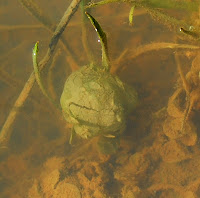

Last Sunday, the Newt Pond had dozens of loose globs of clear jelly attached to pond vegetation, 3/8ths to 1/2 inch in diameter and sometimes covered with debris or algae.


On closer inspection, I could make out several clear circles of eggs within the cluster, each containing either a dark dot or a small, knife-like larvae with a white belly. Because of the small size of the individual eggs, and the loose jelly nature of the irregularly-shaped cluster, I knew these were treefrog eggs. One point to the treefrogs for the large numbers of eggs, another point for their strategic placement at many locations throughout the pond, and a third point for the incidental camouflage.

 In an old trough in the sun by the Monotti Barn, rainwater had collected. Treefrogs had suctioned their way up the tall sides and laid eggs on stems floating in the 3" deep water. Some of these eggs had recently hatched (perhaps because the shallow water is warmer), and the brand new tadpoles rested on their sides on the bottom of the trough like bicolor grains of rice. Another point to the treefrogs for finding innovative places to breed, some even inaccessible to other amphibians.
In an old trough in the sun by the Monotti Barn, rainwater had collected. Treefrogs had suctioned their way up the tall sides and laid eggs on stems floating in the 3" deep water. Some of these eggs had recently hatched (perhaps because the shallow water is warmer), and the brand new tadpoles rested on their sides on the bottom of the trough like bicolor grains of rice. Another point to the treefrogs for finding innovative places to breed, some even inaccessible to other amphibians.
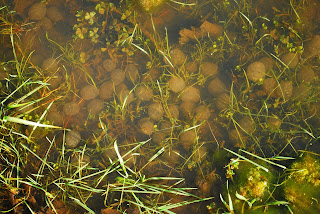
At the Plum Pond, the shallow water was suddenly festooned with piles of semi-transparent ping-pong balls as if the newts had communal egg-laying events. In contrast to the small, delicate treefrog egg masses, the newt egg masses have a firm, rubbery exterior enclosing several dozen eggs. One point to the newts for their sturdy piles of eggs.
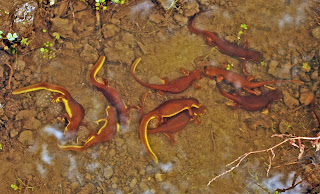 As I was stepping over the Mallard Pond's outlet, I spotted 9 female newts resting together on their sides in a quiet pool. I immediately noticed that these newts were unusually still. Although newts are generally intrepid and not too concerned by my presence (neurotoxin bravado), they usually swim away from the pond edge when I move about. I squatted down for a closer look and noticed that each female was in the process of laying a large egg mass. In the group of nine, I could see egg masses at all stages of emergence and they were surrounded by many previously laid eggs.
As I was stepping over the Mallard Pond's outlet, I spotted 9 female newts resting together on their sides in a quiet pool. I immediately noticed that these newts were unusually still. Although newts are generally intrepid and not too concerned by my presence (neurotoxin bravado), they usually swim away from the pond edge when I move about. I squatted down for a closer look and noticed that each female was in the process of laying a large egg mass. In the group of nine, I could see egg masses at all stages of emergence and they were surrounded by many previously laid eggs. The process was happening very slowly, almost unbearably so for me, and the female newts seemed to be in a trance unaware of their surroundings. One female was even gripping the shoulders of another. I tried not to project my own child-birthing experience on these bright orange amphibians, but the process looked rather difficult. Even after witnessing the event nine-fold at once, I am still baffled that these 3/4- to 1-inch diameter firm masses come out of the narrow newt bodies. One point to the newts for laying such enormous egg masses and another point for undertaking the struggle communally.
The process was happening very slowly, almost unbearably so for me, and the female newts seemed to be in a trance unaware of their surroundings. One female was even gripping the shoulders of another. I tried not to project my own child-birthing experience on these bright orange amphibians, but the process looked rather difficult. Even after witnessing the event nine-fold at once, I am still baffled that these 3/4- to 1-inch diameter firm masses come out of the narrow newt bodies. One point to the newts for laying such enormous egg masses and another point for undertaking the struggle communally.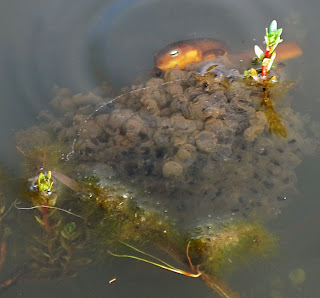

After watching the quiet females deliver the next newt generation, I began to wonder what the male newts were up to. Approximately 30 feet away, I found a group of male newts swimming tight circles around a cluster of red-legged frog eggs. Every now and then, a newt would thrust its head into the cluster, thrash its tail and tug loose and swallow a single large frog egg.
 In late February, I saw single newts thrashing about in a similar way in the Plum Pond. At that time, I realized they were tearing apart jelly and gobbling up treefrog eggs.
In late February, I saw single newts thrashing about in a similar way in the Plum Pond. At that time, I realized they were tearing apart jelly and gobbling up treefrog eggs.After those amazing sightings, I think I will crown the hungry newts as King of the Pond. At least for now. Interestingly, newt egg masses are large and firm perhaps to prevent other species or their own from gobbling them up. I have also read that for some species newt eggs are even more toxic than the adults.
Actually, red-legged frogs, treefrogs and newts return to these ponds year after year, so somewhere within their life cycle, the frogs must have strategies to survive the gobbling nature of the newt. Still, with their female communal birthing pools and sushi-eating males, the newts certainly take the prize for interesting behavior.
 California red-legged frog, Rana draytonii
California red-legged frog, Rana draytoniiCoast range newt, Taricha torosa torosa
Pacific treefrog, Pseudacris regilla
Ah, I'm a year late, I see, but I love this post! I've just written about the rough-skinned newts, too. They're getting busy up here in Oregon now. Your way too?
ReplyDeleteGreat photos!
--Patricia Lichen, www.patriciaklichen.com
the thing about these seasonal patterns is that even if you are a year late, you are just on time or even early. I just checked out your blog and it is exciting to compare Oregon natural history with coastal California. I've been comparing the same with biobabbler in Sierra Mtns and it is interesting. http://biobabbler.blogspot.com/ Your cycles seem like they are completely different since you get summer rain (right?) and we don't. Our newts are going underground for the dry season. I am writing about coast range newts versus rough-skinned newts (Taricha torosa vs T. granulosa) and will get back to you with more questions. thanks for finding and linking.
ReplyDelete